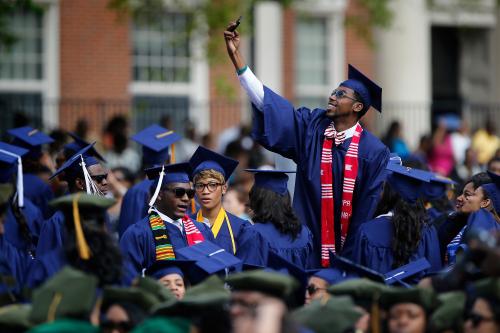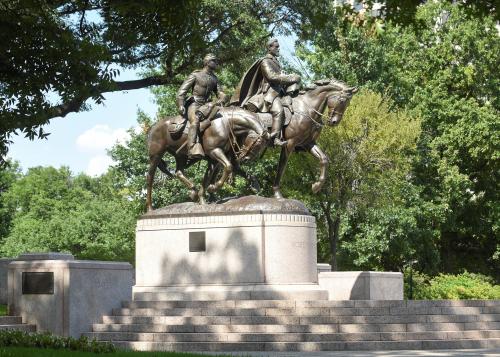This story was produced by The Hechinger Report, a nonprofit, independent news organization focused on inequality and innovation in education. Read more about education in New Orleans.
Proponents of charter schools have bought into the watered down notion of inclusion
Charter schools didn’t create segregation, but the charter school movement isn’t helping to end it either.
When Martin Luther King Jr. said, “We must never adjust ourselves to racial segregation,” he wasn’t suggesting that black kids need white kids and teachers in the classroom with them to learn. King was acutely aware that segregation sustains racial inequality in schools and other institutions. Education reform without an explicit attempt to dismantle the sources of inequality isn’t a moon shot toward justice; it is simply a maladjustment to injustice.
A recent Associated Press analysis of national school enrollment data found that “as of school year 2014-2015, more than 1,000 of the nation’s 6,747 charter schools had minority enrollment of at least 99 percent, and the number has been rising steadily.”
A startling number, but the charter school lobby essentially responded with a version of, “So what?”
“Academics, attorneys, and activists can hold any opinion they want about public charter schools and other families’ school choices,” said a spokesperson for the National Alliance for Public Charter Schools in an official response to the AP story. “In the end, parents’ and students’ opinions are the only ones that matter. And every year, more parents are choosing charter schools.”
New York magazine columnist Jonathan Chait co-signed that dismissal of segregation with a column that essentially argued it’s not really the job of charter schools to change the system of oppression that created schools that perform poorly, “because integrating schools is hard,” and he calls the criticism of increased segregation among charters as merely a “talking point.” For Chait, rising test scores trump segregation concerns.
In the all-charter district of New Orleans — that Chait described at the 2015 anniversary of Hurricane Katrina as “spectacular” in another defense of charters — virtually no (less than one percent) white students attend schools that have earned a “D” or “F” performance rating. But 77 percent of white students are enrolled in “A-” and “B-” rated schools, according to a new report by non-profit advocacy group Urban League of Louisiana. It is unthinkable that this situation would be tolerated if the students’ races were reversed. It is clear that segregation, and who gets a quality choice, matters.
In the all-charter district of New Orleans, virtually no (less than one percent) white students attend schools that have earned a “D” or “F” performance rating.
My colleagues Richard V. Reeves, Nathan Joo, and Grover J. “Russ” Whitehurst at the think tank the Brookings Institution compared the racial composition of the country’s public schools to that of the under-18 population of those neighborhoods. They found that schools more or less look like the neighborhoods that host them.
“The average public school is 2.6 percent less white, 1.8 percent more black, 0.9 percent more Hispanic, and 0.3 percent more Asian than its surrounding neighborhood,” according to the study. No surprise there.
The segregated state of our schools helps maintain the inequitable funding that determines families’ educational options. When the government-backed Home Owner’s Loan Corporation developed color-coded maps to sort out who could receive mortgage lending, blacks who lived in the red sections of the map were not given loans. And of course, the most well-resourced schools just happen to be located in the most expensive neighborhoods.
The Brookings team looked closely at district lines, and they found that if you remove them, many schools become more racially imbalanced. It seems to me that wealthy neighborhoods are using district lines to leverage themselves against demographic shifts. According to EdBuild, a non-profit focused on school finance issues, the most egregious cases of segregation are shown by the roughly 36 districts that were formed since 2000 as a result of secession — when a school district splits from a larger one.
U.S. News & World Report explained the study’s results: “In almost all cases, the communities involved were less diverse and had higher property values than those they left behind.”
The Brookings report found that among the racially imbalanced schools, charters stood out as having a much higher representation of black students. Their imbalance rating is roughly four times that of traditional public schools. (You can see how your school compares through this interactive map). Charters didn’t cause segregation, but they sure aren’t helping matters.
In many cases, school district lines are the more potent Confederate monuments that we still need to take down. Proponents of charter schools say that by disrupting school districts that were largely created along discriminatory and segregated lines, charters improve the number of options you have. And sure, giving kids a quality education is an excellent goal. But getting to the source of inequity is real reform.
Giving kids a quality education is an excellent goal. But getting to the source of inequity is real reform.
In a statement in response to the AP story, Shavar Jeffries, national president of Democrats for Education Reform, said sarcastically, “Apparently, the school segregation problem boils down to black and brown parents choosing schools that aren’t white enough, as if the doors of all-white schools would magically open if only they had the good sense to seek to enroll their children in them.”
We shouldn’t conflate insincere calls for diversity (read: making schools whiter) with demands to topple segregated schools. Schools should get the resources they need, whether middle-class white students attend them or not. Our fascination with inclusion is inherently corrupt, because it is born of the misconception that whiter schools are better. Jeffries makes this point. But education reform absent an effort to dismantle segregated schools is equally bad. To blame teachers, parents, and district bureaucracy (especially when they are black) is to ignore the history of how schools became depressed. To dismiss segregation is to accept structural inequality and the status quo.
We’ve simply given up on the radical idea of integrating schools. The last major effort occurred in 2007, in the Supreme Court case Community Schools v. Seattle School District No. 1. The court ruled that Seattle and Louisville school districts’ efforts to desegregate/integrate schools by using individuals’ race to place students in schools were unconstitutional. The “diverse by design” coalition, a group of deliberately integrated schools that poses more of a threat to structural inequality, offers some hope.
Segregated schools of the past and present are a result of horrible policy choices that most people are willing to accept.
The AP study pointed to the right problem with charter schools: an overrepresentation of black and brown students. As the AP report states, “[L]evels of segregation correspond with low achievement levels at schools of all kinds.” What the AP report, Chait and some charter advocates haven’t said is how willing we are to experiment on the lives of black students and black-majority school districts instead of doing the hard work to eradicate the causes of segregation.
Make no mistake, segregated schools of the past and present are a result of horrible policy choices that most people are willing to accept. There is a reason that after more than 20 years, the research is mixed on charter schools. Schools in black and brown communities were built on broken foundations — i.e., segregation. By not addressing segregation, reformers are turning off the stove when the house is going up in flames.
The Brookings Institution is committed to quality, independence, and impact.
We are supported by a diverse array of funders. In line with our values and policies, each Brookings publication represents the sole views of its author(s).







Commentary
How charter schools are prolonging segregation
December 11, 2017